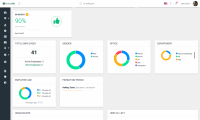The period of the first weeks in a new job and adaptation in the company is an extremely important point of contact between the employee and the employer. To answer the question why it is so important, let's start with the definition of onboarding. The key is to precisely define the areas in the company in which we want to introduce a new person.
The areas that an employee should learn about at the beginning of their adventure with the organisation are:
- strategy, mission, vision and goals of the organisation as well as the direction of its development;
- responsibilities, first tasks and challenges, expectations and development opportunities;
- organisational structure, supervisor and team;
- the procedures and rules by which the company and its employees operate the workplace, necessary tools and equipment.
In other terms, onboarding is also a definition of the stage at which a candidate becomes an employee, and thus, building a positive employee experience should begin. It is during the implementation that the inevitable first impression of the organization, internal communication, working conditions and the atmosphere in the company is created. The perception of these aspects can be left to its natural, spontaneous rhythm or design. The latter approach will allow you to create the highest quality solutions that translate into the entire organization in the long term.
How effective onboarding allows employees to stay longer?
Onboarding allows you to reduce the level of stress that always accompanies new situations. The employee knows what to expect when joining the company. These activities also allow you to build a relationship with the team faster.
Getting to know the organizational culture at an early stage will allow for easier implementation, from the very first day of work. Thanks to faster adaptation to the organization and implementation into the team, the employee is able to shorten the time to achieve full productivity and independent performance of his duties.
These activities also allow you to maintain a high level of motivation to start a new job. They keep the enthusiasm. They also allow you to avoid wasting time when it comes to preparing the workplace and settling all formal issues - the employee can start to get into his duties faster.
Onboarding is also actions aimed at improving the candidate experience and the image of the employer. A strong brand on the local market allows for easier recruitment.
What does onboarding give an employee?
It is also the time to get to know the boss's expectations towards the newly recruited person, and integrate with the team. Benefits of onboarding for the employee:
- learn the way the organisation works
- integrate with members of his team
- has time to understand their role and place in the company
- gets acquainted with the tasks assigned to him in the new position
- learns, develops and gains invaluable experience
- learns the communication chain - knows who to turn to in case of a problem / doubt.
Benefits of onboarding for the employer:
- return on investment for recruitment - the employee begins to work independently in a new position faster
- lower employee turnover
- greater level of identification with the company that affects commitment and loyalty
- faster implementation and the process of adapting a new employee
- lower employee stress level - higher motivation and productivity.
Measuring effectiveness and evaluation
An implemented employee is one who has enough knowledge about the company to freely move around the project or tasks. It is also characterized by high motivation to prove its worth and creativity. This is the moment when he is development-oriented, but often unaware of organizational limitations. This means that with the end of onboarding, there is still room to complete specific areas of knowledge about the organization.
However, the key is to define your onboarding goals and then evaluate the process. Thanks to this, it can be constantly improved and adapted to the current needs of the team.
The multitude of areas that require design and implementation is a clear signal that it is worth using dedicated tools. The selection of the tool must be related to the goals that the company wants to achieve, but it is certainly worth looking at LMSs (learning management system) and tools for building commitment (employee experience). They allow for the harmonization and structuring of activities, as well as for the automation of its individual elements and process evaluation.


 Posted on Jan 11, 2022 by Brainy HR
Posted on Jan 11, 2022 by Brainy HR


